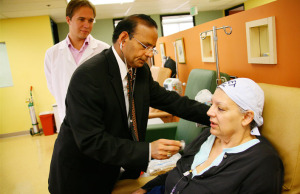Pulmonary Cancer Surgery
Pulmonary cancer surgery is most commonly used to treat early stage non-small cell lung cancer (NSCLC). Usually performed in earlier stages, surgery is one of the forms of treatment for this type of lung cancer. Depending on the patient and their individual diagnosis, surgery may be used in conjunction with other treatment methods, such as radiation and chemotherapy.

Pulmonary Cancer Surgery in Los Angeles
When the board-certified oncologists at the Cancer Center of Southern California determine that a multi-disciplinary approach is the best lung cancer treatment, they often may consider some sort of surgery in addition to chemotherapy and radiation therapy. There are several types of lung cancer surgery that can be used, in some cases with curative intent where possible:
Lobectomy
Each pair of lungs contains five lobes – two on the left and three on the right. This surgery consists of removing an entire lobe to remove lung tumors located inside the lobe. This is typically the most common form of lung cancer surgery.
Pneumonectomy
This procedure involves the removal of an entire lung.
Sleeve resection
This surgery is most common when a tumor is located in an airway. Used to prevent a pneumonectomy when possible, this procedure involves surgically removing the portion above and below the tumors in the airway, and then sewing the healthy portions of tissue together.
Segmentectomy or wedge resection
For patients with weaker and diminished lung capacity, this procedure is used to remove just a portion of the affected lobe in order to help preserve as much lung function as possible.
When treating patients for lung cancer, the cancer specialists at Cancer Center of Southern California will also check for potential spread (metastasis) of lung cancer cells to neighboring lymph nodes. The lymph nodes are removed for biopsy to check for cancer cells.
The type of surgery prescribed will depend on several factors. For patients that are generally healthier and have stronger lung capacity and function, the oncologist may recommend full removal of the affected node or lung in order to ensure that all of the cancer cells are removed, and to diminish the possibility of a recurrence of the cancer.
VATS (Video Assisted Thoracic Surgery)
Technology is increasingly improving the way that cancer surgeons treat and remove tumors. Less invasive options like robotic surgery and video assisted thoracic surgery make it possible for oncologists to remove tumors using smaller incisions and with less disruptions and risk to the healthy tissue and organs surrounding the cancer cells.
Lung cancer surgeries are usually performed with incisions through the ribs and the side of the chest, known as a thoracotomy. In a VATS procedure, a smaller incision is used, where a thin tube affixed to a video camera is inserted to help the oncologist visualize the inside of the chest cavity and lungs in order to get a clearer and more accurate visualization of the cancer cells and margins. Like most minimally invasive surgical procedures, video assisted thoracic surgery allows for faster healing and recovery, and shorter hospital stays.
Next, read Lung Cancer Doctors Los Angeles


